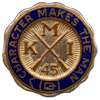
El Patio Hotel was the heart and hub of historic Venice |

El Patio Hotel was the heart and hub of historic Venice |
|
Constructed at a cost of $125,000, the hotel and arcade actually comprised two buildings facing each other and joined on the first floor by a roofed, open-ended arcade.
PHOTOS PROVIDED BY VENICE MUSEUM & ARCHIVES
For decades, the iconic El Patio Hotel has remained at the heart of historic downtown Venice. And for most of that time, it literally was the hub of the community’s daily life as well. “The pharmacy was there, which had a nice fountain where you could get a sandwich or a soda, and everybody went to the post office to get their mail. Many went to the barbershop for a haircut, and if you were visiting the city, you could stay at the hotel upstairs,” said Mary Jo (Miles) Pattison, whose parents purchased the building in 1948 and operated the El Patio for 63 years. Originally known as the Ennes Arcade and Hotel Valencia Building, the two-story structure was constructed in 1926 by Stanton and Elizabeth Ennes. Mr. Ennes was general manager of the Brotherhood of Locomotive Engineer’s (BLE) Real Estate Company from September 1927 until March 1928. The George Fuller Company of Chicago, the same company responsible for most of the building in Venice for the BLE, constructed the Ennes Building. It was completed in January 1927 at a cost of $125,000 and had a Mediterranean Revival design. It was actually two buildings that faced each other and were connected on the first floor by a roofed, open-ended arcade. Seven stores, besides the hotel lobby and post office, occupied the first floor, with some opening directly onto the arcade. By July of 1927, the building housed the Turner Clothing Store, the Arcade Barber Shop, the Prime Hardware Company, the Venice News Company, and an office of the Florida Power & Light Company. The Valencia Hotel, located on the second floor, comprised 32 rooms and 16 shared bathrooms. Each room opened to an outside balcony or the second story patio, while the hotel’s lobby was located on the first floor, to the left of the arcade. Living quarters for the proprietor’s family was located just behind the lobby, with the Venice Post Office at the southern end of the building. Glenn Stephens, who worked for the Post Office for 38 years, said there was no mail delivery in those days. “You had to go to the post office and get your mail out of your box,” Stephens said. “I remember going there as a boy to get our family’s mail. Our mail box number was 193.” Stephens remembers earning 90 cents an hour when he was hired as a substitute postal clerk in 1949. If they worked after 6 p.m. or before 6 a.m., they earned an additional 10 cents per hour. Joe Henault operated the Arcade Barber Shop for many years. After he moved down to the Florida Keys, George Mitchell and Elihu Roberts operated the shop. When the Kentucky Military Institute (KMI) began wintering in Venice in 1932, the cadets would visit the shop to get their hair cut. The barbershop is still in operation today.
Brothers-in-law James Dick, left, and Jerry Meadows operated the Rexall Pharmacy in the building for many years. It was a popular spot to get your prescription filled while grabbing a sandwich or milkshake at the soda fountain. PHOTO PROVIDED BY VENICE MUSEUM & ARCHIVEThe hotel’s name was changed to the “El Verano” in the mid-1930s. A number of changes in management as well as renovations to the building were reported in the Sarasota Herald from 1930 to 1938. The Oct. 2, 1938, edition of the paper announced that the hotel was re-opening as the “El Patio Hotel.” On May 31, 1942, a group of engineers arrived in Venice and opened an office in the building in order to begin planning for what would become the Venice Army Air Base. Many improvements continued to be made in the ensuing years. The storefronts and upstairs front windows facing Venice Avenue were modernized in the 1950s, replacing the original arched windows. A portico that covered the sidewalk from the building to the street was added in 1966. The arcade was enclosed and narrowed in 1972 to make available additional retail space. And two narrow patios on each side of the building were replaced with retail space. The lobby was moved upstairs in the 1990s in order to accommodate retail stores on the first floor. Faye and Leslie Miles purchased the El Patio Hotel for $50,000 in 1948 and the family continued to operate it until April 2011 when it was sold for $2.195 million to a local investor. The hotel has since been converted into one two-bedroom and 15 one-bedroom apartments. The El Patio was added to the National Register of Historic Places on Nov. 10, 1994. |
| Kentucky
Military Institute
www.kmialumni.org Send e-mail to: kmimail@kmialumni.org Copyright © All rights reserved. |
 |